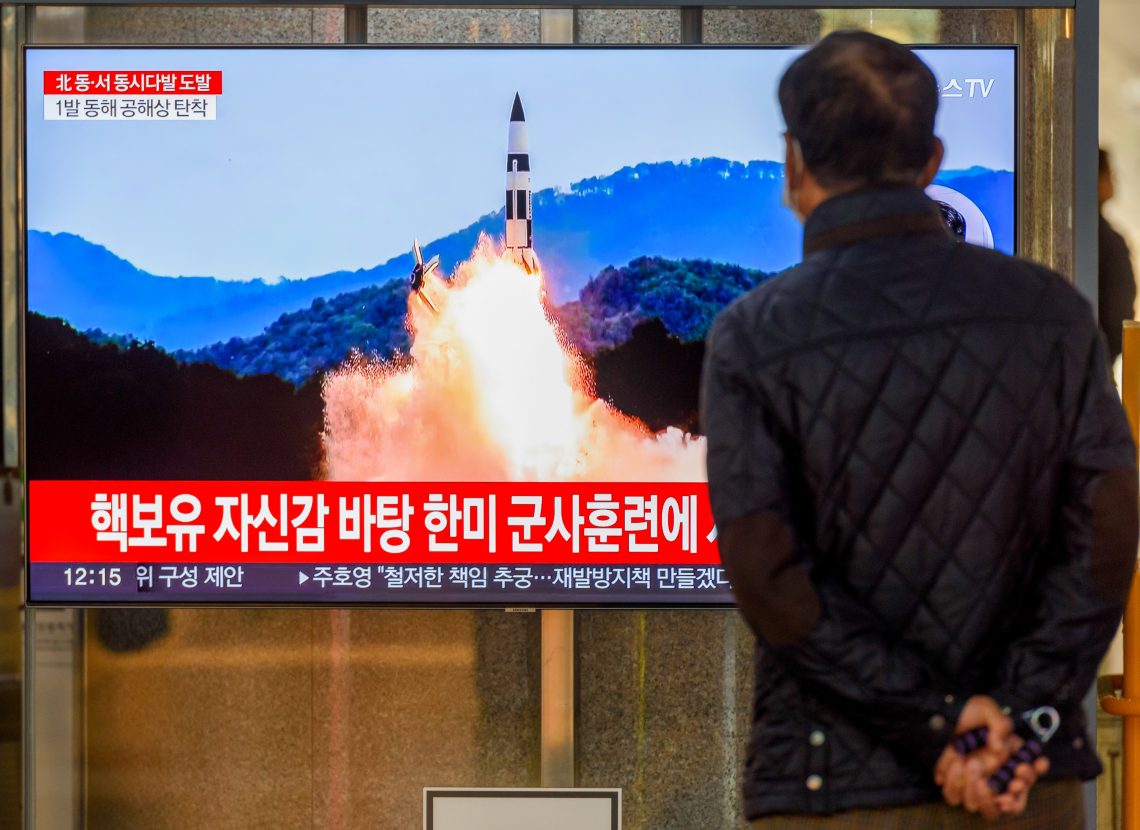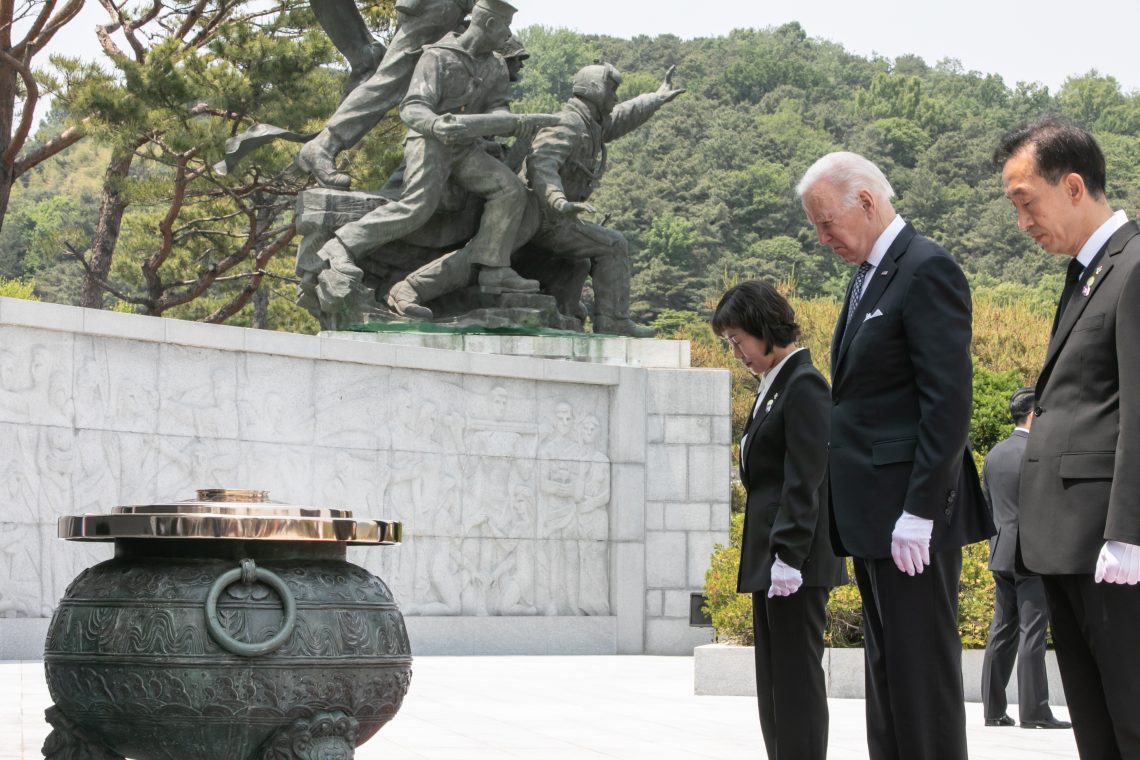Defiant North Korea demands global attention
Missiles launched by Pyongyang are forcing the United States and allies to reconsider strategies for a stable Korean Peninsula.

In a nutshell
- North Korea seeks to put itself back on the international agenda
- Missile tests remind the U.S. and Japan of downside risk
- China wants to avoid a regional nuclear arms race
Amid the ongoing war in Ukraine and fears in Asia about a potential conflict over Taiwan, the tense situation on the Korean Peninsula has slid into the background of the world’s attention. This state of affairs had been irking the leadership in Pyongyang, possibly motivating North Korean leader Kim Jong-un to insert his country into the headlines in October by launching a ballistic missile across Japanese airspace. The regime fired two more salvos in early November, including 23 missiles on a single day, its largest-ever such deployment.
After a period of calm during the Covid-19 pandemic, North Korea appears to be back on track, provoking the international community with renewed sanctions violations. If a new round of negotiations with the regime is to take place, both Washington and Tokyo will have to rethink their strategies toward Pyongyang.
It is certain that North Korea only engages in major military action at the Supreme Leader’s behest. While the most recent missile tests are worrying – as is the prospect of another North Korean nuclear test – these latest provocations are nothing new. Until this year, 2019 had seen the greatest number of provocative actions by the North, with no fewer than 27 missiles launched, including two flown over Japan’s airspace. That year also saw North Korea perform a nuclear test.
For some observers, the volley of rocket tests of various ranges, including one missile that landed dangerously close to the South Korean coast, is an indication that another nuclear test is in the works. Officially, Pyongyang insists that its tests are a response to an increase in South Korean and American military exercises, and to more hostile rhetoric from new South Korean President Yoon Suk-yeol.
Lessons from Ukraine
North Korean strategists are closely following events in Ukraine. For some time, especially since the U.S. efforts at regime change in Iraq and Syria, Pyongyang has been convinced that maintaining a credible nuclear deterrent is essential for its survival. Only a nuclear bomb, the thinking goes, can keep the Americans at bay. This is the main reason why such an impoverished country spends so much of its scarce resources on ambitious military programs; nothing is too expensive or ambitious to keep the Kim dynasty in power.
Both China and North Korea believe that the U.S. administration is not paying them the attention needed to reduce tensions.
In the case of the war in Ukraine, Pyongyang has taken particular notice of the leeway enjoyed by Russian forces due to its huge nuclear arsenal. This is also the context for a national law passed in September declaring North Korea a nuclear-armed state, and Kim Jong-un pledging that the country would never give up its nuclear weapons. The nuclear bomb has become the regime’s raison d’etre.
Finally, the Ukraine conflict has given North Korea an opportunity to remind the world that it, too, has rocket technologies that may be of interest to the militaries of other countries. There are plenty of rogue nations that could do with North Korean rockets.
Letter to Washington
Significantly, 2017, the year that saw a spike of at least 21 North Korean missile tests, was followed in 2018 by a historic summit between Kim Jong-un and then-U.S. President Donald Trump. This was a remarkable event, with the two leaders declaring their “love” for one another. It certainly pleased Mr. Kim, who saw himself in the international limelight and on an equal standing with the most powerful person on Earth.
The event did not produce any concrete results. From the perspective of Pyongyang, the continued U.S. refusal to recognize the existence of the North Korean state makes substantive progress impossible. The regime also sees threats to its security in the regular maneuvers conducted by military forces from the U.S., Japan and South Korea. With every major exercise, tensions in the region increase.

U.S. President Joe Biden has plenty on his plate with economic concerns and several international crises. Nevertheless, the message from North Korea is clear: we are capable of causing upheaval in the fragile Far East, a region with much at stake for the world economy and for American interests.
In that respect, the recent missile tests might even carry an indirect message from China – reminding Mr. Biden that stability in the Far East depends upon the cooperation of Beijing and its influence in Pyongyang. There can be no doubt that both China and North Korea believe that the White House is not paying them the attention required to reduce tensions, as had been the case at least during part of the Trump administration.
Regional messages
The October tests also sent a more direct and threatening signal to Japan. The Japanese government was humiliated into issuing a warning to its citizens to seek shelter as a ballistic missile flew over the northern island of Hokkaido. Apart from the fact that Japan was either unwilling or unable to bring down the North Korean missile, the incident was deemed a threat to civil aviation and an act of recklessness.
The message to the Japanese public was that North Korea has the military means to do substantial damage to Japan, and to cast doubt on the ability of Japanese defense to respond effectively.
From Japan’s point of view, the implication is that Tokyo must urgently enhance its military prowess. Many citizens who still support the pacifist constitution will now have second thoughts about the security challenges facing their country. There are even indications that a growing number of Japanese people favor nuclear defense capabilities if the country is threatened by nuclear arms.
North Korea’s ambitious plans present China with the threat of nuclear expansion in the Far East.
The conservative Yoon Suk-yeol has been president of South Korea since May of this year, replacing Moon Jae-in, who faced criticism for being “too soft” toward the North. Relations between the two Koreas, tense at the best of times, have become even more fractious.
Pyongyang sees President Yoon as a “warmonger” who provokes the North with risky military maneuvers. Such exercises, jointly undertaken by the U.S., South Korea and Japan, are used by North Korea as a pretext for ballistic missile tests and, most recently, provocative war games using fighter aircraft. President Yoon reacted more firmly than his predecessor, and it remains to be seen whether frictions on the peninsula will further increase in the months and years to come.
Finally, the missile tests also carried a message to Beijing, albeit a subtle one. After the Covid-19 pandemic hit North Korea hard and with heavy sanctions continuing to bite, the Kim regime has become even more dependent on its principal ally, China. Nevertheless, Pyongyang has its own, largely obscured agenda. It is not identical to Beijing’s, most importantly on the subject of nuclear weapons: China opposes the nuclearization of the Korean Peninsula as well as that of Japan. North Korea’s ambitious plans thus present China with the threat of nuclear expansion in the Far East.
Scenarios
The region is entering a phase of growing tensions. The competing interests of the four key actors – China, North Korea, South Korea and Japan – present four distinct strategies that will evolve in the years to come.
Beijing’s interest is to keep North Korea as a constant reminder of a potential fresh outbreak of violence on the Korean Peninsula. This dynamic simultaneously reminds Tokyo and Seoul of their secondary status in the region. They are forced to deal with the minor irritant of North Korea in their own security strategies, while China plays in the big leagues alongside the United States.
Japan, on the other hand – recognizing that a hegemonic status, akin to China’s, is not within its reach – will be pressed to develop a more innovative approach toward South Korea. Over the past 20 years, Japan has been steadily losing out to South Korea, which rivals Japan in terms of soft power.
Given its rapidly shrinking and aging population, Japan has no interest in the unification of the two Koreas. Its most immediate strategy is to contain the North and at the same time pursue more constructive cooperation with the South. In view of China’s dominant position on the Asian continent, the most effective strategic tack is a constructive relationship between the two democracies and Western allies, overcoming still-lingering resentments of the past and converging on common values.
China also aims to break the current stalemate between Washington and Pyongyang, one way or another. This would entail a resumption of talks between the two countries, leading to eased sanctions and reduced tensions in the Far East. China will not resort to pressuring Pyongyang, even if North Korea continues to instigate with its ballistic missiles and nuclear tests. On the other hand, Beijing’s security interests are not served well if North Korea’s constant provocations end up boosting nationalist and militarist forces in Japan – possibly even advancing the country’s nuclear armament.








